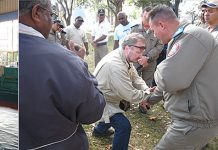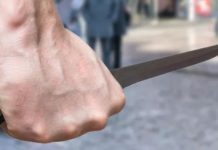Whenever new students come to Defense Science classes they are usually taken aback by the emphasis on defensive knife training. I remind them that the majority of violent attacks they hear about in the media frequently comes via edged weapons. I also point out that it’s important to know how to use a knife — so they can better defend themselves against one. Most people exclaim that they could never use a knife against another person.” However, if their children’s lives were threatened, they would certainly do far worse.
The reality is, there is a small but still significant percentage of the world’s population that feels no empathy for their fellow man, and no remorse for maiming or killing them. These are sociopaths and psychopaths — they don’t care.
For the past few years knife attacks have been on the rise throughout the world. Much of the violence by African and Middle Eastern immigrants in Europe has come in the form of crazed knife attacks. Even China has seen an explosion of random large-scale knife killings, and in New York City, knife attacks are almost a weekly occurrence.
With this state of escalated violence, knowing how to defend oneself from an edged weapons attack is an indispensable part of everyone’s self-protection plan. IMO, defensive knife training is more important than unarmed defense training. The few groups we teach that appreciate this type of instruction the most are: military, law enforcement and prison guards – that’s because their edged weapons programs are severely lacking.
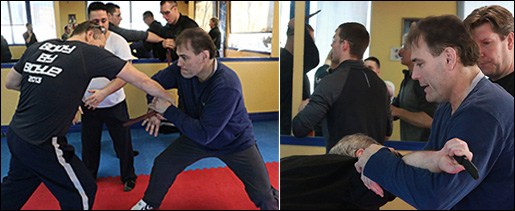
Since random weapons-based violence is becoming more of the norm these days, it’s inconceivable to think that some people actually choose not to carry a weapon? Most people cannot defend themselves unarmed against a knife. Even those individuals that have superior empty-hand skills — that’s for the movies. You need a gun or a knife in real life.
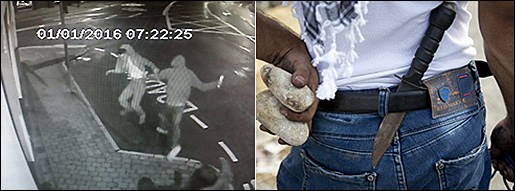
Criminals favor knives because they are easily obtainable, convenient to carry, conceal, and above all are silent. They also cause life threatening injuries. There are actually some progressives who believe that these killers just need love and understanding — however having a knife plunged into your body will quickly remedy this type of thinking. It’s not important to understand why these psychos attack, it’s imperative to defend yourself from these criminals, and that only comes with defensive knife training.
I’ve always been amused when individuals boast that they can handle themselves in a street attack, or better yet state that the odds of a knife attack against them are slim to nothing. But in many cases aren’t they the first ones who are attacked? Furthermore, when attacked they just stand there in disbelief? New students who come in for lessons who were recently attacked — still can’t believe it!

Individuals that don’t at least have some kind of minimal defensive knife training will be completely helpless in an attack — they will freeze and can be seriously injured, or even worse, have the opportunity to meet the grim reaper. Even experts in the field can only hope for a 50-50 chance of survival — however 50% is much better than 0%, n’est-ce pas?
Modes of Attacks and Types of Edged Weapons Used
Census organizations state that 70% of the population of Europe, America and other first-world countries live in urban areas. The types of attacks encountered in these locales are very similar across the board: robberies, gang attacks, racial and religious attacks, drunken disputes, and ego driven violence.
According to statistics from law enforcement agencies in Europe and America, the majority of knives used in urban attacks are 1. folders (w/blades 4”-5” long) and 2. kitchen knives (w/blades 8”-10” long).
There are exceptions but they are the outliers (every once in a while you will hear about a machete attack). Folders of course are weapons of convenience and are extremely easy to conceal. There are also weapons of opportunity that include screwdrivers, ice picks, and box-cutters.
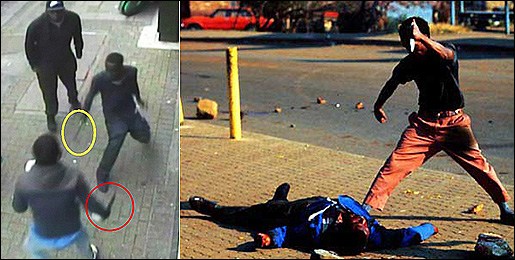
Modes of Attack
A large majority of defensive tactics instructors don’t really understand the full gamut of edged weapon attacks. They routinely teach a handful techniques that they perceive to be for commonplace knife attacks. That’s because their knife defense lessons are usually tacked onto the end of a general self-defense program. Most knife attacks are not announced; they are typically spontaneous — sudden surprise attacks. Therefore in many cases you need to deal with the attack before you can draw your own weapon. However, having access to it will greatly increase your odds.
Types of attacks can range from: knife on body (robberies / threats) running at the victim (racial and religious attacks), Surprise attacks (when the aggressor suddenly takes out a hidden knife), hacking attacks, thrusting, slashing and more.
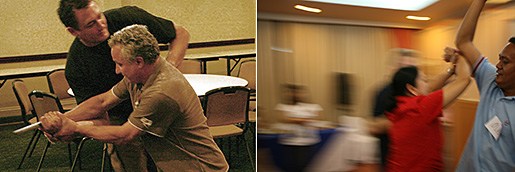
As with all weapons, serious defensive knife training with the knife is an absolute prerequisite for its use. The problem these days is that it’s difficult to find a credible and holistic curriculum. That is, learning: 1. Unarmed defense against a weapons attack, and 2. To use an edged weapon as defensive tool.
Moreover, the physical skills must be supplemented by an understanding of the psychology of violence. Knowing the concepts of situational and environmental awareness, being able to recognize the pre-indicators of an attack, how to profile individuals and groups, dealing with the approach, making a plan, and how to avoid, evade and escape. Unfortunately, this vital information is rarely taught.
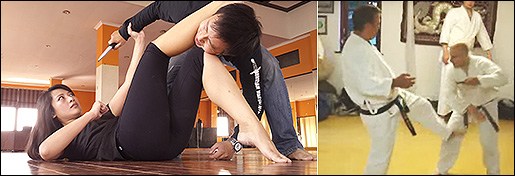
Not Too Many Choices Available Today
Sadly, traditional martial arts still adhere to impractical and archaic conventions. They assume their traditional style knife counters will get them out of harms way — they never do. Sport fighters have absolutely no idea how to deal with edged weapons or multiple attackers – they don’t receive defensive knife training. I have met a few skilled MMA fighters who were badly cut because they assumed their fighting skills would be enough — they weren’t — fortunately they survived.
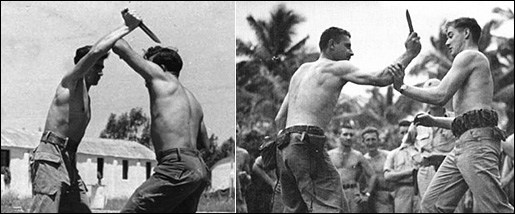
American and British combatives do teach a rudimentary form of knife defense training based on WWII military combatives, however it’s important to recognize that defensive knife tactics have evolved since then. Many Israeli combat knife programs have also not kept up, particularly with knife on body counters.
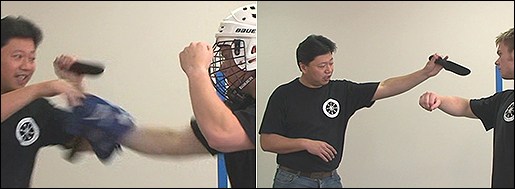
So where can you find defensive knife training that will provide greater odds for staying alive? There are both Western and Eastern approaches. Much of the Western approach has evolved from fencing. Since fencing uses longer weapons, several individuals and groups have successfully adapted the benefits that fencing affords to the knife. These are measure, timing and footwork (often lacking in many SE Asian knife styles). Knife systems from James Keating, Raymond Floro and Defense Science have worked to bridge this gap.

A Brief Review of Knife Culture in The West
Europe has had a rich knife culture peppered throughout its history. Most Western cultures, since ancient times used knives but in similar fashion to northern and central Asia — they used them as adjunct weapons to the sword. However the knife was always favored for personal protection.
During the Renaissance, extremely long daggers were used in conjunction with swords. This type of fighting was called “Espada-y-Daga.” There is a great commonality between this style of European fighting and FMAs (Filipino martial arts). Some say the Spanish version of “Espada-y-Daga” influenced FMA’s. Since it was seen only in the Philippines, (a country controlled by Spain for 330 years), and not in the rest of South East Asia.

The Stiletto evolved from the Rondel dagger in the late 15th century in Italy, and differed from the dagger in that it had a triangular blade. It was used to penetrate deep into the body for a guaranteed kill, and was quite often used for assassinations.

In Spain, from the 17th to 19th century, the Gitanos people (Romani) in the Andalusian region of Spain used the Navaja (a large folding knife) for both utility purposes and fighting. From 1808 – 1814, the guerrilleros often caused havoc for Napoleon’s foraging scouts in occupied Spain using this weapon. The Navaja eventually spread to Latin America and the Philippines.

From 18th century America, frontiersmen began using large knives for: chopping, carving, skinning and fighting. In 1827 Jim Bowie’s legend was born and sealed into American folklore forever with the duel at the Sandbar. This is where he fought and killed two men in a duel with a large knife (after being shot and stabbed). This led to the popularity of the Bowie knife.
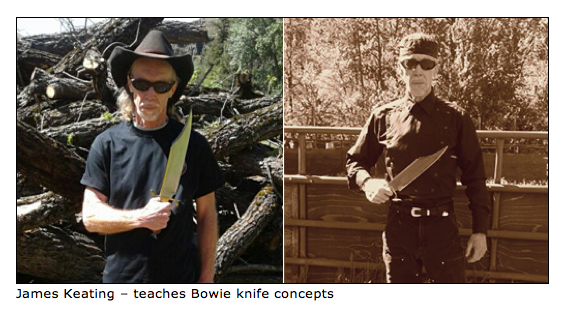
Apart from HEMA (Historical European Martial Arts) working to recreate some of the older sword and knife styles, there are a few individuals who still teach some of these methods today, especially the Bowie.
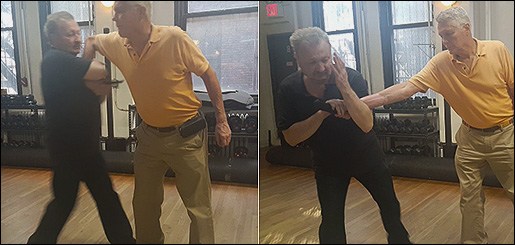
Finding Instruction
It’s much more challenging to find Western knife instruction than FMA’s, but it’s available. Some of the newer fencing academies offer HEMA related courses, but in general the knife still takes a backseat to the sword.
If you are searching for a FMA’s school, look for a group that offers defensive knife training classes and/or private lessons apart from the stick. Stick training can be useful, however the primary goal, at least in the beginning, is to learn how to avoid a knife attack and how to counter it. Not all schools are adept at teaching edged weapons. Many offer knife training based on the stick, which isn’t what you want. (Part II of this article will more fully clarify the FMA knife programs).
Need to Know
Unlike in Hollywood movies, once you cut an attacker, it doesn’t necessarily mean he will miraculously drop to the ground or catapult six feet into the air offering no further resistance. People can be remarkably robust. Think of your attacker as a zombie, never turn your back on him until he is unable to continue, or he runs away. If you can escape do so ASAP. Even individuals who are mortally wounded have the ability to keep on attacking for a minute or so.

Legal Considerations
Besides attaining physical skills one of the most important factors to consider are the legal ramifications of defending yourself with an edged weapon. The moment you draw your knife you are engaging in deadly force. You are certainly entitled to protect yourself and family from a deadly assault, but once the imminent threat is over you cannot continue the attack, if he tries to escape let him go. Chasing him and exacting revenge is murder.
If you are arrested and face a trial [in many countries], you need to prove that your response was proportional to the threat. The main point you must communicate is that “you were trying to stop the attacker from harming you”. This concept is particularly important these days since the legal system in America is slowly changing to favor the criminal — as they are already doing in Europe. More judges are now punishing individuals who defend themselves, even in their home — the “Stand your Ground” law isn’t as solid as it once was. Never, ever say that you had the right to defend yourself and that your violence was justified unless you prefer to change your residence to a federal facility.

Your Weapon And The Law
Before you start carrying a knife, it’s important to make sure you don’t get arrested for illegal carry. The UK has some of the most stringent and almost comical knife laws, (insuring that innocent civilians won’t be able to defend themselves). Getting caught carrying any locking blade over 3” and you may face a 4-year prison sentence – but don’t worry, the criminals always have a weapon at the ready? In many European countries, a locking knife is technically against the law (translation = any useful knife.)
NYC also has some of the most restrictive knife laws in the US. From 2000 to 2012, more than 70,000 people were arrested for carrying a blade. Most were contractors carrying cutting tools they needed for the job. Nevertheless many served jail time. In 2013 the city eliminated the “Stop and Frisk” laws, and naturally this caused crime to skyrocket up to 19% — and the number of people shot went up 9.2%.
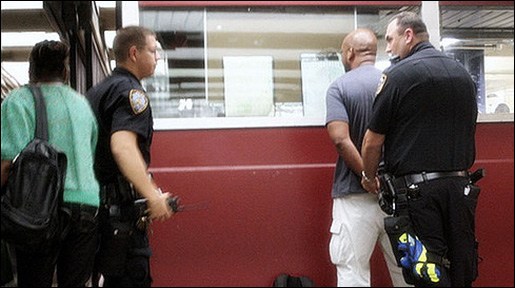
For the short term, and in general, there’s no need to worry about stop-and-frisk in NYC, unless you use the subway. Police can request to search your carry bag as you enter the station, which will lead to a body frisk. (Note: you can legally decline such a search by leaving the station). If you enter any official government building or court, check your bag and pockets you will be arrested on the spot if you have a weapon on you.
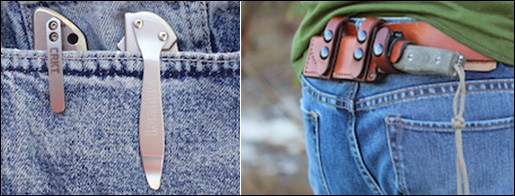
If you need to carry a weapon for your own security, the most important consideration is to avoid contact with law enforcement entirely and to make sure that your weapon is completely out of sight. That is, never show a knife clip, or any cutting tools out in the open, don’t make it easy for the police to arrest you.
*To know what can happen after an arrest, see this link.

To contact WR Mann and Defense Science visit his listing on the Martial Arts Schools and Businesses Directory by clicking on the image on the left.
Recommendations: The Short List
These are people and programs we know who are teaching defensive knife training. In Part 2 of this article we will include a more extensive list.
James Keating
Master at Arms: Several programs including FMA’s and Bowie Knife
Oregon, USA
jamesakeating.com/
Raymond Floro
Floro System knife training and FMA’s – Kalis Ilustrisimo
Sydney, Australia
rayfloro.net/
Kelly McCann
Offers a solid multi-day course
Virginia, USA
Kembativz.com
Jim Wagner
For those who only have one day to learn knife defense
California and INTL. Seminars
Jimwagnertraining.com
Defense Science
Programs on all aspects of knife training
NYC and INTL. Seminars
*New Brunswick, Canada Location
Defensescience.com
Coming Soon:
The Case For Defensive Knife Training in the 21st Century – What You Need to Know – Part 2



